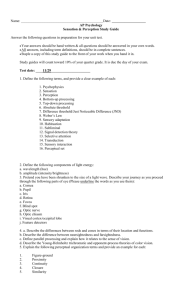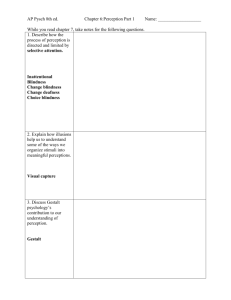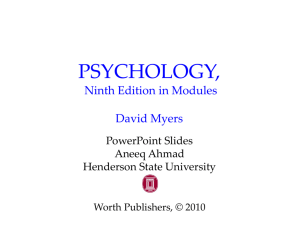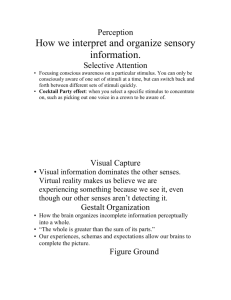Perception
advertisement
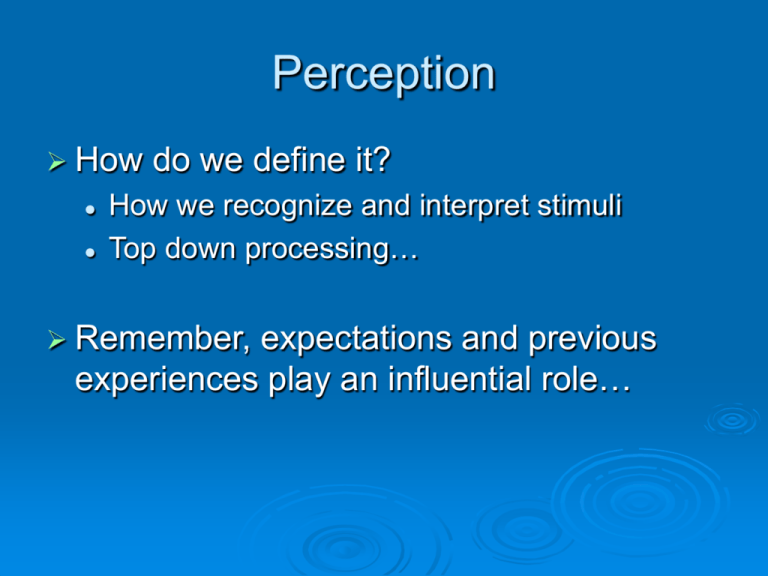
Perception How do we define it? How we recognize and interpret stimuli Top down processing… Remember, expectations and previous experiences play an influential role… Selective Attention Our senses can take in approximately 11,000 bits of information at a time BUT… We can only focus on one thing at a time… Neisser’s Basketball Study Inattentional Blindness Focusing on one stimulus prevents us from noticing others The dancing gorilla (bear) Texting and driving! 2 readers, one listener…. Cocktail Party Effect Can listen to only one voice at a time • Can notice gender • Can detect name Just how much do we notice? Change blindness We fail to notice changes in our environment (when we are focusing on something else) Pop Outs! Striking distinctions grab our attention Perceptual Illusions Mislead us by playing on the way we organize and interpret our sensations (challenges our schema!) Reveal how we normally organize our sensations (thus clues to mechanisms of perception) Visual Capture: Vision is our dominant sense (effects how we perceive our other senses) • McGurk Effect (Youtube/edu) Perceptual Organization Visual Agnosia See all parts of an image, but not the whole, (or meaning) Gestalt (“form”) “The whole is greater than the sum of its parts” We tend to see, or group images as a whole, not as individual or isolated parts A natural, or innate form of perception Gestalt: (How we group objects) Figure and ground (sometimes can be reversible) Gestalt Proximity Gestalt Similarity Gestalt Continuity Gestalt Closure Depth Perception Binocular Cues (interplay of two eyes) Retinal Disparity: each eye sees object from slightly different angle (brain computes difference in vision to judge depth) Convergence: eyes move together as item gets closer (brain detects convergence of eyes as measure of depth) The Finger Sausage! Depth Perception Monocular Cues Relative Size Monocular Cues Linear perspective Monocular Cues Texture gradient Monocular Cues Interposition Monocular Cues Relative Height Monocular Cues Relative Clarity Monocular Cues Relative Motion (The faster it moves…) Monocular Cues Light and Shadow Motion Perception Phi Phenomenon Troxler Effect With loss of sight- motion is usually first to be restored Perceptual Constancy Perceiving an object as unchanging despite a change in stimulus Key factors: Experience, Expectation (Rules of perception) Size Constancy: As stimulus changes, we literally see changing size, but we know size has not changed due to experience and context of objects surroundings Size Constancy http://www.eruptingmind.com/depth-perception-cues-other-forms-of-perception/ Shape Constancy We know shape is constant even though our angle and thus vision of object changes Lightness (Color) Constancy We see objects as having consistent color, even as changing conditions alter the wavelength reflecting off the object. http://www.psy.ritsumei.ac.jp/~akitaoka/light5e.html Perceptual Set “To believe it is to see it” A mental predisposition Experiences give us a perceptual set, or assumptions that influence how or what we see… Context Effect The context in which a stimulus appears affects how we perceive it… “…eel is on the wagon.” “…eel is on the orange.” Sensory Deprivation / Restored Vision Adults with vision for first time (cataract surgery) Have Sense of colors, detect figure from ground No depth perception, no perceptual constancy (cortical cells not developed) *Much of perception is learned during critical period in early development Perceptual Adaptation Our perception can adapt to change in stimuli, environment Inverted goggles!! Perceptual Constancy pages 250-262 Shape constancy Size constancy Light constancy Sensory Deprivation and Restored Vision Perceptual Adaptation Perceptual Set Context Effects


